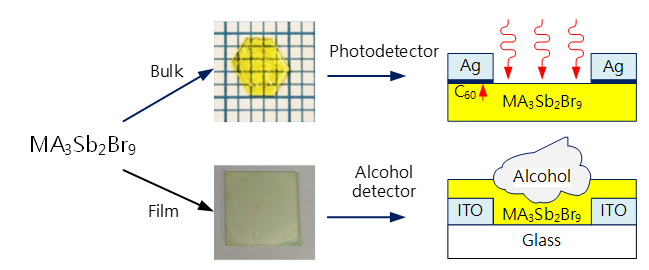Video Article Open Access
Properties of Lead-Free Perovskite-Like MA3Sb2Br9 Crystal Growth and Its Sensing Applications
Chien-Min Hun, Lung-Chien Chen*
Department of Electro-Optical Engineering, National Taipei University of Technology, Taipei 10608, Taiwan
Vid. Proc. Adv. Mater., Volume 3, Article ID 2206288 (2022)
DOI: 10.5185/vpoam.2022.06288
Publication Date (Web): 12 Sep 2022
Copyright © IAAM
Graphical Abstract

Abstract
In this work, we studied a lead-free perovskite-like material (CH3NH3)3Sb2Br9 (MA3Sb2Br9) in bulk and film and applications for photodetector and alcohol detector, respectively. The MA3Sb2Br9 bulk visible photodetector is prepared by inverse temperature crystallization method and the MA3Sb2Br9 film alcohol detector is prepared by spin coating method. First of all, we have fabricated a photodetector based on MA3Sb2Br9 perovskite-like single crystal, which as a perovskite-like photosensitive layers play an important role in the photoelectric properties of photodetectors. Here, MA3Sb2Br9 single crystals were synthesized by inverse temperature crystallization process with precursor solution at three different growth temperatures at 60, 80, and 100 °C. According to photoluminescence (PL), it could be seen that the three kinds of MA3Sb2Br9 single crystals with different growth temperatures have a very narrow PL emission peak at the wavelength of 523-527 nm, and FWHMs of 39.9, 42.4, 47.9 nm. The PL intensities of single crystals at the three growth temperatures were different. Among them, the MA3Sb2Br9 single crystal grown at 60 °C has a highest PL intensity, followed by 80 °C, and 100 °C was the lowest. MA3Sb2Br9 single crystal with an optimum growth temperature of 60 °C present a low trap density of 2.63 × 1011 cm−3, high charge carrier mobility of 0.75 cm2 V–1 s–1, and excellent crystal structure and optical absorption properties. This MA3Sb2Br9 perovskite-like photodetector exhibits low dark current of 8.09 × 10−9 A, high responsivity of 0.113 A W–1, and high detectivity of 4.32 × 1011 Jones. On the other hand, recently, we also have fabricated an alcohol detector based on the MA3Sb2Br9 film with transistor type. Here, MA3Sb2Br9 films were spin-coated on the glass substrates with ITO pattern. X-ray diffraction (XRD) patterns, absorbance, and current voltage were employed to examine the characterizations of the MA3Sb2Br9 films and devices. One diffraction peak at 29.9o corresponding to the cubic crystal (022) phase was observed. The position of absorption edge of MA3Sb2Br9 film is around 500 nm. It is corresponding to the band gap of MA3Sb2Br9 crystal. This MA3Sb2Br9 perovskite-like alcohol detector exhibits high responsivity of 1.5 and 19.9 A W–1 for 0.01% and 5 % alcohol, respectively.
Keywords
Perovskite-like; MA3Sb2Br9; photodetector; alcohol detector.
Acknowledgement
This work was supported by the Ministry of Science and Technology (Taiwan) under contract Nos. 110-2221-E-027-125 and 109-2218-E-027-003-MY2.
References
- C. M. Hun, C. H. Tien, K. L. Lee, H. Y. Lai, L. C. Chen, Sensors 2021, 21, 4475.
- B. Yang, Y. J. Li, Y. X. Tang, X. Mao, C. Luo, M. S. Wang, W. Q. Deng, K. L. Han, J. Phys. Chem. Lett. 2018, 9, 3087–3092.
Biography
Lung-Chien Chen received his Ph. D degree in the electrical engineering from the National Tsing Hua University, Hsinchu, Taiwan, in 1999. He has a professional career in industrial institution: Manager and Vice Assistance President in Formosa Epitaxy Photonic Incorporation (1999–2002). In 2002, he joined National Taipei University of Technology (Taipei Tech), Taiwan, as a faculty member of Department of Electro-Optical Engineering. Currently, he is a full Professor of Taipei Tech and his main research interests include compound semiconductor growth (GaSb, AlInGaP, III-nitrides, zinc oxide, and perovskites), material analysis, and device fabrication technology, light-emitting diodes (LEDs), photodetectors, and solar cells. He has authored or coauthored more than 160 journal papers and 5 books or book chapters. He is the holder of more than 21 patents in his fields of expertise. Prof. Chen is the Optica (former of Optical Society of American (OSA)) Senior member and the IEEE Senior member. He was elected as the fellow of Royal Society of Chemistry (RSC) in 2019. In 2021, Prof. Chen is on the Elsevier global top 2% of scientists list.
Video Proceedings of Advanced Materials

Upcoming Congress



